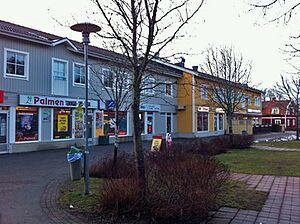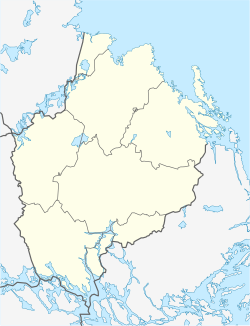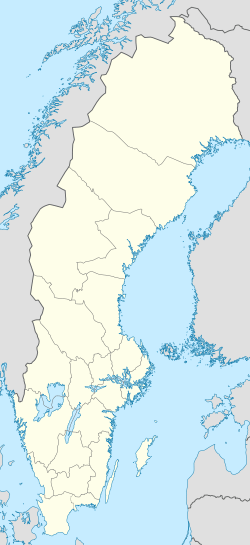Storvreta facts for kids
Quick facts for kids
Storvreta
|
|
|---|---|

Shops in Storvreta
|
|
| Country | Sweden |
| Province | Uppland |
| County | Uppsala County |
| Municipality | Uppsala Municipality |
| Area | |
| • Total | 3.04 km2 (1.17 sq mi) |
| Population
(31 December 2020)
|
|
| • Total | 6,360 |
| • Density | 2,092/km2 (5,419/sq mi) |
| Time zone | UTC+1 (CET) |
| • Summer (DST) | UTC+2 (CEST) |
Storvreta is a town in Uppsala Municipality, Uppsala County, Sweden. It is located about 15 kilometers (about 9 miles) north of the city of Uppsala. In 2020, about 6,360 people lived there.
Exploring Storvreta's Past
Ancient Times in Storvreta
Long, long ago, people lived in the Storvreta area. Archeologists have found signs of homes and burial sites from the Stone Age and Nordic Bronze Age. This shows that people have been here for thousands of years!
Many years ago, much of the land around Storvreta was under the sea. After the last Ice Age, the land slowly rose up. By around 2000 BC, more land was ready for people to live on.
Storvreta as a Farming Village
For a very long time, the people in Storvreta were farmers. They grew crops on the rich land that used to be under the sea.
In 1539, during the time of King Gustav Vasa, a record book was made. This book mentioned Storvreta. At that time, the village had four main farms. Later, in the 1800s, there were ten farms. There were also smaller farms and crofts, which were small rented farms. One of these was for a soldier who served the king.
The Arrival of the Railway
A big change came to Storvreta in the late 1800s. A railway line was being built between Uppsala and Gävle. In September 1874, the tracks from the north and south met in Storvreta! A new train station had just been built there. The railway officially opened in December 1874.
The train made it much easier to travel and move goods. Because of this, Storvreta started to grow. It changed from a quiet farming village into a place with many businesses. The most important business was making furniture.
Storvreta's Furniture Industry
Many furniture factories opened in Storvreta. They made all kinds of wooden items.
Blomqvist's Furniture Factory
Johan Erik Blomqvist was one of the first big business owners in Storvreta. He moved there in 1892 and started making furniture at home. In 1900, he built a factory in the center of Storvreta. His factory made furniture for banks, shops, and even university buildings.
In 1925, a desk made by Blomqvist's factory won an award at a big fair in Paris, France! After that, the Swedish Royal Court and a famous museum ordered furniture from them. Johan Erik's son, Jabez Blomqvist, took over the business in 1949. At its busiest, the factory had up to 50 workers. Johan Erik Blomqvist also helped build a church in the village. The factory closed down a few years after Jabez retired in 1966.
Other Furniture Makers
Anton Lund was another furniture maker in Storvreta. He used to work for Blomqvist's, but then started his own factory in 1920. His factory made beds and other furniture. They also made skis using a special method he invented.
The biggest furniture company in Storvreta was AB K J Pettersson and Sons. Karl Julius (K J) Pettersson started his business in 1933 with his four sons. They made more and more furniture, so they built a bigger factory and a furniture shop. In 1953, they built an even larger factory.
Pettersson's company was known for its special sofa beds. They also made other furniture. When the first student housing was built in Uppsala, Pettersson's made the furniture for it. The company had 50-60 workers during slow times and about 100 during busy times. They had a large furniture shop near the E4 motorway, but it burned down in 1979. The factory closed in 1980.
Other Businesses in Storvreta
Storvreta also had other businesses in the 1900s. There were factories that made furniture for cinemas. Two smithies made tools and metal items for the furniture makers and farmers. There was also a dairy (for milk products) and a brewery (for drinks). Outside Storvreta, there was even a fur farm that raised minks and silver foxes until 1957.
A very old mill, called Ekeby kvarn, is just outside the village by the Fyris river. There has been a mill there since the 1200s! The building you see today was built in 1791. This mill belongs to Uppsala University. There was also a sawmill nearby that helped farmers and furniture factories. It was taken down in the 1960s.
Storvreta Today
Since 1971, Storvreta has been part of Uppsala municipality. Many people who live in Storvreta now work in Uppsala or even Stockholm. It's easy to get to these cities because there are regular buses and trains. The Upptåget train stops in Storvreta and goes to Tierp and Gävle.
Schools and Learning
Storvreta has four primary schools. Three are for younger students: Lyckeboskolan, Storvretaskolan, and Pluggparadiset. One school, Ärentunaskolan, is for older students (grades 7–9).
Ärentunaskolan had a fire in 1986, which also destroyed the public library that was inside the school. A new school building opened in 1989. Today, Ärentunaskolan has about 500 students from Storvreta and nearby towns like Vattholma and Skyttorp. Storvreta also has other shops, restaurants, and a library that opened in a new building after the fire.
Sports and Community
Storvreta IBK is the local floorball club. It's one of the biggest floorball clubs in Sweden! They have teams for children as young as 6 years old. Their men's team has won the Swedish Super League, Sweden's top floorball league, four times!
Storvreta is part of Ärentuna Parish in the Church of Sweden. The Ärentuna Church was built in the 1300s and is about 5 kilometers (3 miles) west of Storvreta. There is also a small chapel in the village. Another church, Lyckebokyrkan, belongs to the Uniting Church in Sweden. It was built in 1982.
Notable People from Storvreta
- Stefan Michnik
- Carola Häggkvist



